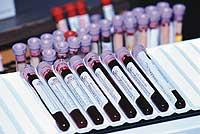Biochip instead of genetic analysis

Family hypercholesterolemia associations have been fighting this scourge for years. The objectives so far have been two: reduce treatment and facilitate the detection of the disease. In this way, in a few years it is intended to diagnose and as soon as possible all people who may have the disease, since many times, after suffering a heart attack, it is known that the patient had a familial hypercholesterolemia.
It seems that both are on track to reach. On the one hand, since the beginning of the year the drugs are cheaper and as far as diagnosis has been advanced a lot, since a biochip of genetic analysis is being marketed. The Basque company Medplant Genetics/Progenika has developed a biochip called Lipochip®. This biochip allows a quick and safe diagnosis.
Timely diagnosis possible
So far, a table of criteria from the World Health Organization has been used to detect familial hypercholesterolemia (FH), which takes into account blood cholesterol levels, cases of heart attack in the family, etc., but this method is not entirely reliable. The most precise method, undoubtedly, is to perform a genetic analysis, but it is long. From now on, however, the biochip made specifically for the detection of FH will greatly facilitate the work: the result can be collected the day after the extraction of a blood sample to the patient.

Due to mutations of an FH gene, the biochip has been designed to detect these mutations. It consists basically of a glass plate with the auxiliary sequences corresponding to each of the FH causing mutations, oligonucleotides. For the analysis, the DNA is extracted from the patient's blood sample and placed on the fluorescence marked plate. The laser light allows you to see at what point the sample attaches most strongly to the plate and, consequently, determine the patient's mutation if it were.
Diagnosis is safe, that is, if a mutation is detected it can be said without a doubt that the patient has FH. However, non-mutation detection does not mean that the patient does not have FH but does not have mutations that the biochip detects.
In fact, the disease is caused by mutations in a certain gene found in the short arm of chromosome 19. And around the world some 700 mutations are known that cause FH; to put it in some way, the mutations are geographically separated, that is, in each village certain mutations appear.

In the territories where many peoples have moved, the genetic heritage of these peoples has remained in the genome of their inhabitants, and mutations are part of that heritage. For example, in the Spanish population 181 mutations are known, of which 70 have not been found anywhere else. Lipochip® is specially designed to detect mutations in this territory. It detects 154 of them and soon the oligonucleotides corresponding to another 25 mutations will be added. Similar or very different mutations may appear in other territories, so for the biochip to be useful it will be necessary to adapt to local mutations.
Another great advantage of this chip is that it is known what is the exact mutation of the patient, which allows the doctor to prescribe the most appropriate treatment. In fact, not all mutations have the same incidence on the patient's metabolism, some are more severe than others and require more effective treatment.
Cholesterol, effects and agents
FH is a disease of cholesterol metabolism that passes from one generation to another through autosomal dominant inheritance. To know the influence of these inherited mutations, go to the liver. In fact, the FH gene encodes the LDL receptor, which is the receptor that liver cells have to regulate the level of cholesterol in the blood. Thanks to them, if the blood cholesterol is excessive, it is removed from the blood and entered the cell, thus decreasing the cholesterol levels in the blood.

Conversely, if LDL receptors do not work properly, blood cholesterol is excessive and gradually builds up in the walls of blood vessels and produces arteriosclerosis. This accumulation makes blood circulation difficult and, among other things, can form coacids, and if not enough oxygen reaches the cells, a heart attack occurs. Therefore, it is not surprising that one of the main causes of heart disease is cholesterol.
However, not all cases of HF are the same and metabolic problems can be very different. In the most serious case, the patient has received the FH gene from both parents, it is homozygous. In these cases, the liver does not receive cholesterol, so the patient has excess cholesterol in his blood from birth. In addition, it is found at very high concentrations, higher than 1000 mg/dl.
Homozygote FH is the most difficult to treat and in many cases it is necessary to use drugs in combination to minimize side effects. In this case, cholesterol also accumulates under the skin (forming structures called xantalemas) and in ligaments (forming xanthemas).
The usual thing, however, is a heterozygous mutation, in which the mutation is the only gene allele. The liver does not regulate cholesterol levels well, as it does not have enough receptors in the cells. Treatment simpler than homozygous mutation, since the concentration of cholesterol is also lower, between 300 and 500 mg/dl. However, the blood concentration of cholesterol is above the usual 120-240 mg/dl, being essential treatment.

Unfortunately, FH cannot be cured, but at least with proper treatment the patient can lead a normal and long life. Thanks to this lipochip® it is expected that in a few years all patients have been diagnosed. It will be an expensive but profitable project for health organizations over time, as hospital admissions to treat heart attacks, stroke, murmurs and other diseases that do not favor their diagnosis and treatment would be much more expensive.
Familial hypercholesterolemia in dataThe high cholesterol rate is not rare today. This hypercholesterolemia is attributed to a diet rich in fats and not exercising. But in some cases, despite proper diet and sports, the blood cholesterol rate is high. This is due to familial hypercholesterolemia and it is advisable to make a safe diagnosis as soon as possible. In Euskal Herria there are about six thousand people who suffer from this genetic disease, but most do not know. Only 30% of patients are detected. The rest lead a normal life, without adequate treatment to reduce the cholesterol rate, with the consequent risk of suffering a heart attack. Unfortunately, most cases of HF are diagnosed after a heart emergency, which in many cases is too late, as the patient has died. Statistics on patients with HF are really dramatic: life expectancy is between 20 and 30 years lower than the rest. In addition, men are more at risk for heart attack than women: 75% of men with HF have a heart attack before age 60. |





